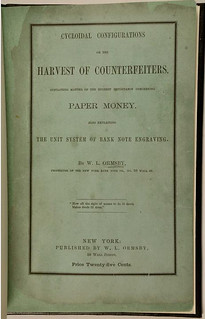
PREV ARTICLE
NEXT ARTICLE
FULL ISSUE
PREV FULL ISSUE
SELECTIONS FROM THE STACKS-BOWERS SULLIVAN SALEA consignment of numismatic literature is offered in the Stack's Bowers Spring 2019 Baltimore auction. Here are some lots that particularly caught my eye. See the complete sale online for much more. -Editor Lot 9233: 1850 Singerly's Autographical Detector 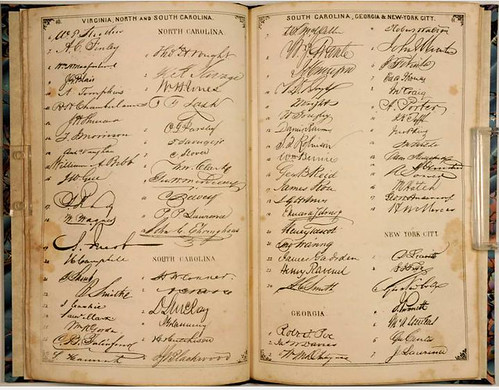 Singerly's Lithographic Chart of Signatures: Being a Supplement to the Western Review, Containing a Fac Simile of the Signatures of the President and Cashier of almost every Bank in the U.S. Pittsburgh: Benj. Singerly, Publisher and Proprietor, Review Building, 1850. 32 pages. 8to. 26.5 x 17 cm. Brown wraps. Now finely bound in quarter blue morocco by Sam Ellenport with blue marbled paper boards. Gilt spine title with raised bands. Contents complete and pages relatively fine and clean. Cover wrap with chipped off lower right corner. Likely, next to impossible to obtain another. Notes: Autographical detectors provide a compilation of bank office signatures as they appear on genuine bank notes. The concept was to detect counterfeits by comparing authentic signatures with those appearing on banknotes; a difficult approach even in today's high tech society. According to Dillistin: "While the facsimile signatures presented in this detector were of great value to those handling State bank notes who might question the genuineness of signatures appearing thereon, they were no doubt of inestimable value to the swindler and crook engaged in counterfeiting such notes." Autographical detectors are rare with only a few numismatic literature auction appearances cited. This detector is a great, great rarity. Not listed in Dillistin. The contents with Singerly's Lithographic Chart of Signatures does not list the bank titles, distinguish between presidents and cashiers, nor type out the spelling of individual names. Rather, the publication only provides lithographic signatures arranged by state with no identification; furthering the impracticality of the publication in identifying counterfeit notes above the deficiencies already cited for signature examiners in general. These are fascinating books that took an incredible amount of effort to compile and produce. There was clearly a great market for them at the time, but I have to agree with Dillistin about their equally great value to counterfeiters. -Editor To read the complete lot description, see: Lot 9247: Ormsby's 1862 Harvest of Counterfeiters Notes: Missing from many famous numismatic libraries like Fuld. Not in the ANS library catalog. Ormsby was controversial and this is perhaps his most controversial work. Cover price was 25 cents. Another highlight from this impressive collection. A great prize for the numismatic bibliophile. I don't have one in my library and have never seen one in person. -Editor To read the complete lot description, see: Lot 9283: Heath's Microscope 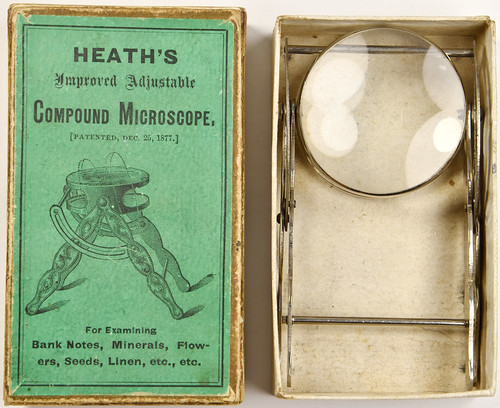 1877 Heath's Compound Microscope with Original Distribution Box. Extremely Fine. Enclosed in Custom Leather Solander Box Heath, Laban. Heath's Improved Adjustable Compound Microscope, [Patented, Dec. 25, 1877], For Examining Bank Notes, Minerals, Flowers, Seeds, Linen, etc., etc. Folding stand with legs decorated with scrollwork, glass magnifying lens which tilts, stored in the original distribution cardboard box, with pictorial green cover label, as issued. The microscope when folded open is 12.5 x 5.5 cm wide at the base and 6 cm in height. The lens has a diameter of 4.5 cm. Box label with titles, illustration of folded out microscope, and patent date. The microscope and its box are housed in a three quarter brown leather solander box with raised bands, spine compartments lettered in gilt, designed as version "A" as designed and executed by Sam Ellenport. The box with the microscope fits snugly in its interior compartment. The microscope is essentially as made and in choice condition. Some trivial soiling on the original box. However, the survival of the original box is just short of a miracle. The Heath's three-legged circular magnifying lens and its original box realized $10,200 as Newman Part VIII, lot 29236. That had never been seen. We do not recall an example of this microscope being offered in a currency auction. The custom solander box created for this and the following matching box are gorgeous. Distinguishing Features: The two compound microscopes in the MJS Collection are the same overall design, but the scroll work on the outsides of the legs on each differs. Also, this version does not have the patent date stamped on the inside of the legs as the next example does. These have been designated as versions "A" and "B" and are so designated on the spine labels of the solander boxes. Very cool item. I've never seen one of these, either. Fantastic companion for a collection of Heath's Counterfeit Detectors, which the sale is replete with. -Editor To read the complete lot description, see: Lot 9287: 1866 Naramore Photographic Detectors in Original Box 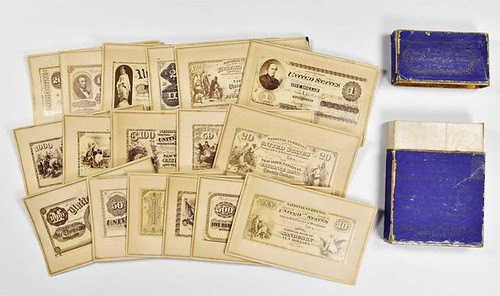 Naramore, R[obert] C. Naramore's United States Treasury and National Bank Note Detector. Pocket Edition. Being Exact Copies of the Genuine Plates, Photographed from the Proof Sheets, By Permission of Hon. H. McCulloch, Secretary U.S. Treasury. Published by American Photograph Co., Bridgeport, Conn. [1866]. 18 individual 10 cm. x 6.3 cm photographic cards, housed in original two piece, blue Cardboard Box with gold lettering. Nearly all of the cards in this set are choice condition. However, a few have some minor mounting remnants at the top of the backs. A full set in original box is rarely seen. Original cardboard box expertly repaired by Alan Grace, 12/1995. Now housed in a sumptuous, octavo size navy half leather solander box, marbled boards, five raised bands, leather spine label, spine compartments decorated in gilt, and blind tooling by Alan Grace. Beautifully made with snug compartment for the original box and the cards it contains. Ex: Charles Davis Sale 23, December 14, 1991, lot 456. Notes: The 18 photographs include U.S. Notes: $1, $2, $5, $10, $20, $50, $100, $500, and $1000; and National Bank Notes: $1 (Pittsburgh National Bank of Commerce), $2 (Washington National Bank of Boston), $5 (National Union Bank of Swanton, Vermont), $10 (Second National Bank of Sandusky, Ohio), $20 (New York National Exchange Bank), $50 (New York National Exchange Bank), $100 (New York National Exchange Bank), $500 (Manufacturers National Bank of Philadelphia), $1000 (Fourth National Bank of City of New York). It is interesting to note Laban Heath's second edition counterfeit detector (also published in 1866) illustrates a counterfeit $20 on the Fourth National Bank of City of New York. As cited in Davis auction sale 23: "The earliest use of photography in counterfeit detection, and tied with the Nathaniel Paine work on Massachusetts currency as the first American numismatic work using that technology. The images taken from unsigned proof sheets with the permission of Treasury Secretary McCulloch, appear in four forms: as a single sheet with the 18 images arranged three by six; with the single sheet mounted on a printed black card with a brass eyelet for hanging; on cards housed in a morocco pouch; and as offered in the rare original cardboard box." Naramore's were issued without text, limiting their usefulness to comparison and detection alone, versus the educational approach employed by Foote, Gear, Eastman, Peyton, Heath, and Wilbur." To read the complete lot description, see: 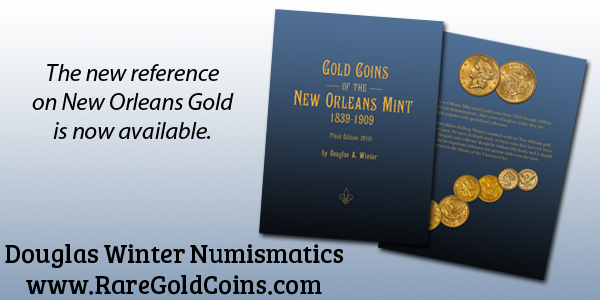 Wayne Homren, Editor The Numismatic Bibliomania Society is a non-profit organization promoting numismatic literature. See our web site at coinbooks.org. To submit items for publication in The E-Sylum, write to the Editor at this address: whomren@gmail.com To subscribe go to: https://my.binhost.com/lists/listinfo/esylum All Rights Reserved. NBS Home Page Contact the NBS webmaster 
|
